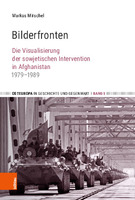Bilderfronten
Die Visualisierung der sowjetischen Intervention in Afghanistan 1979–1989
Author(s)
Mirschel, Markus
Collection
Knowledge Unlatched (KU); Swiss National Science Foundation (SNF)Number
104892Language
GermanAbstract
Das Ziel der UdSSR: eine afghanische Stabilität. Das Ergebnis: eine sowjetische Instabilität.
Als die Sowjetunion 1979 Soldaten nach Afghanistan verlegte, geschah dies im Geheimen – offizielle Bilder gab es nicht. Die Militärzeitung Krasnaja Zvezda sowie das Zentralorgan Pravda agierten zu Beginn der 1980er Jahre als Partner im Geiste. Die UdSSR als Friedensmacht stand den Genossen in Kabul auch visuell helfend zur Seite. Als die letzten sowjetischen Soldaten 1989 das Land am Hindukusch verließen, war das Ereignis im Fokus der medialen Öffentlichkeit. Was war geschehen? Der extern geführte Konflikt auf afghanischem Boden war zu einer innersowjetischen Auseinandersetzung über die mediale Deutungshoheit, die soziale Verantwortung sowie den Umgang mit den Ereignissen erwachsen. Die Studie betrachtet den strategischen Gebrauch fotografischer Bilder zum sowjetisch-afghanischen Konflikt und wertet sie als Impulse für eine gesellschaftliche Transformation.
Keywords
History; Sowjetisch-Afghanischer Krieg; Geschichte der UdSSR nach 1945; Pressefotografien; Kalter Krieg; Europäische GeschichteDOI
10.7788/9783412514976ISBN
9783412514976OCN
1135844965Publication date and place
Köln, 2019Grantor
Imprint
BöhlauClassification
Cold wars and proxy conflicts


 Download
Download Web Shop
Web Shop